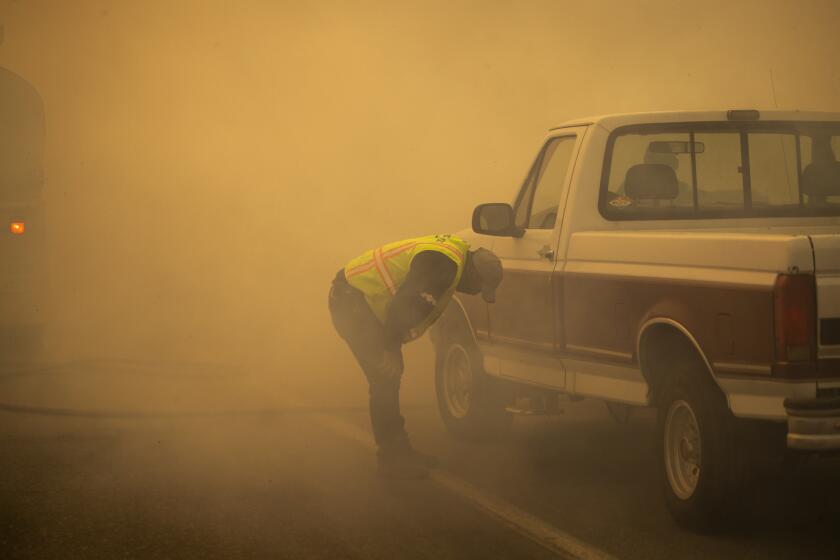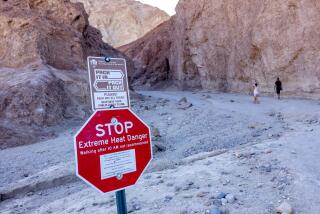California sizzled with three straight months of record heat and raging fires

- Share via
In the midst of the state’s most destructive wildfire season, California shattered temperature records in August, September and October.
All three months were the state’s warmest on record, according to a new report by UCLA climate scientist Daniel Swain.
“The long-term warming trend during the peak of fire season in California has been especially pronounced,” Swain said on Twitter, “and 2020 really puts an exclamation point on that.”
In August, a ferocious heat wave saw temperatures in Death Valley reach a blistering 130 degrees — thought to be the highest temperature on Earth in nearly a century, if not ever. Temperatures in September and October, too, skyrocketed to new heights. Over Labor Day weekend, Woodland Hills clocked the hottest official temperature on record in Los Angeles County, 121 degrees.
Death Valley may have recorded Earth’s highest temperature in 90 years. Data show it is also be among the top three highest temperatures ever measured in Death Valley.
In October, a heat wave prompted a statewide flex alert as Southern California saw temperatures as much as 25 degrees above normal.
“There were nearly 400 daily high temperature records broken across California in September,” said Karin Gleason, a meteorologist with the National Centers for Environmental Information at the National Oceanic and Atmospheric Administration. “In October, approximately 300 daily high temperature records were set.”
Gleason attributed the warming trend to a persistent ridge of high pressure across the Western U.S. that allowed for scant cloud cover, little to no rainfall and plenty of sunshine. She said it’s a trend that is likely to continue in years to come.
“In a warming climate, we expect to see more record warm temperatures broken than we may have seen in the past,” she said. “It is expected to become more commonplace.”
Similar records were set in Nevada, Arizona, Utah and Oregon, Swain said.
The sizzling heat was met with dangerous dryness. Precipitation was close to zero across California in September and October, and two-thirds of the state is in moderate to extreme drought conditions, Gleason said.
Experts say the combination of the two extreme factors — dryness and heat — helped pave the way for an unprecedented wildfire season in the state. More than 4 million acres have burned in California, fed by large swaths of bone-dry vegetation that acted as fuel for hungry flames.
Christine McMorrow, spokeswoman for the California Department of Forestry and Fire Protection, said increasing global temperatures also created an earlier spring, which has resulted in a fire season that is about 75 days longer than it was 50 years ago.
“We’ve got a longer period of time that our vegetation starts to grow and dry out,” McMorrow said. “By the time we get to ... August, September and October, which are the height of fire season, the fuels have had that much more time to dry.”
Six of the 20 largest wildfires in California history have burned this year, according to Cal Fire, and at least 31 people have died in the blazes.
Record heat and dryness in the late summer and early fall were also factors in poor air quality, as wildfires spewed smoke and ash into California’s atmosphere. Residents up and down the West Coast experienced Martian-red skies, layers of ash and soot and health advisories urging people to stay inside with doors and windows shut — a particular challenge for a pandemic-stricken population desperate for time outside.
In August, wildfires created a plume of smoke that spanned more than 1,000 miles, large enough to be seen from space and forceful enough to reach all the way to Europe.
The South Coast Air Quality Management District issued smoke and windblown dust advisories across Southern California due to wildfires.
And in October, gusty winds carried residue from wildfire burn scars into the L.A. region, creating, at one point, the worst air quality in the nation.
The months-long sauna of heat, smoke and dryness was enough to push some Californians to rethink their future in the state.
“My teens are now sending me homes on Zillow out of the area,” said one Santa Rosa resident during the Sonoma County fires in September. “We are all in some form of therapy. My 6-year-old needs me to hold her when she smells smoke.”
The National Weather Service said conditions are expected to change this weekend, when Southern California will experience a notable cooldown and its first chance at rain in several months.
Although the forecast may offer some relief, experts said Californians shouldn’t get too comfortable.
“Certainly, if you were going to say the next 10 years are going to be warmer than the last 10 years, you’d probably have a decent shot [at being right],” said Mike Halpert, deputy director of NOAA’s Climate Prediction Center.
Halpert said this year’s winter outlook favors “a continuation of above-average temperatures and also general below-average precipitation.”
But he said that while overall trends are pointing toward warming, seasonal and sub-seasonal variability can allow for fluctuations that make it challenging to speak in finite terms.
“The easiest forecast I can make for sure is that the 2021 annual global temperature will be above average,” he said. “That’s certainly going to be correct.”
Some Californians don’t know how much more they can take.
“Summer’s become increasingly miserable, and if I am ever lucky enough to afford a house, it might just burn down,” said Cassie Elliott, an El Sereno resident who grew up in Burbank.
Elliott said the state’s increasing extreme weather makes a future in California seem like a poor investment. She is considering relocating to Washington or Oregon.
“Thinking of moving makes me very sad, because I love Los Angeles and California in general,” Elliott said, “but fleeing to locations with more stable water supplies and cooler temperatures seems necessary.”
More to Read
Sign up for Essential California
The most important California stories and recommendations in your inbox every morning.
You may occasionally receive promotional content from the Los Angeles Times.













